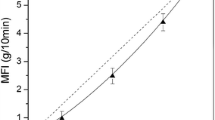Abstract
Thermoviscoelastic properties of phenolic resin/polymeric isocyanate binder systems (i.e., ISOCURE Parts I and II) are reported. The effects of blend composition and the reaction between the binders on these properties of the systems are also considered. The viscous properties of binders and their blends were measured using computer-controlled rotational viscometers (Brookfield HBDV-II+ viscometer and HAAKE Rotovisco 12 rheometer in the cone-and-plate mode). The elastic properties of the phenolic urethane polymer (the blend composition) were measured by means of a modified jet thrust technique based on measuring the thrust of a liquid jet. Although both binders are Newtonian liquids, their blends exhibit viscoelastic non-Newtonian fluid flow behavior. The viscosity of the blends increases both with time and with an increasing Part I content and may reach comparatively high values at high values of either parameter. This behavior is explained as a result of the rubbery nature of the phenolic urethane polymer, which was produced as a product of reaction between Part I and Part II. The use of the jet thrust method allowed determination of the relaxation time of various blends at different shear rates.
Similar content being viewed by others
REFERENCES
P. R. Carey and J. J. Archibald, FoundryManage. Technol. 1:8 (1977).
P. R. Carey and G. Sturtz, Foundry Manage. Technol. 3:17 (1995).
V. L. Streeter, Handbook of Fluid Dynamics (McGraw-Hill, New York-Toronto-London, 1961).
D. R. Oliver and R. Bragg, Chem. Eng. J. 5:1(1973).
D. R. Oliver and R. C. Ashton, J. Non-Newton. Fluid Mech. 2:367 (1977).
J. M. Davies, J. F. Hutton, and K. Walters, Polymères etLubrification, Colloq. Int. CNRS No. 233, (Paris, 1975), p. 61.
D. R. Oliver, Can. J. Chem. Eng. 44:100 (1966).
J. R. Fried, Polymer Science and Technology (Prentice Hall, Englewood Cliffs, NJ, 1995), pp. 387–388.
S. S. Kutateladze, V. I. Popov, and E. M. Khabakhpasheva, J.Appl. Mech. Tech. Phys. 1:45 (1966).
Author information
Authors and Affiliations
Rights and permissions
About this article
Cite this article
Bakhtiyarov, S.I., Overfelt, R.A. Thermoviscoelastic Properties of Phenolic Resin/Polymeric Isocyanate Binder Systems. International Journal of Thermophysics 23, 221–233 (2002). https://doi.org/10.1023/A:1013917413611
Issue Date:
DOI: https://doi.org/10.1023/A:1013917413611




